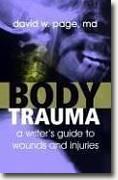Body Trauma
David W. Page, MD
book reviews:
· general fiction
· chick lit/romance
· sci-fi/fantasy
· graphic novels
· nonfiction
· audio books
· author interviews
· children's books @
curledupkids.com
· DVD reviews @
curledupdvd.com
newsletter
win books
buy online
links
home
for authors
& publishers
for reviewers

 |
Body Trauma: A Writer's Guide to Wounds & Injuries David W. Page, MD Behler Publications Paperback 240 pages February 2007 |
|
One of the most necessary tools in a writer's belt is conflict. There has to be something going on in a story or the reader will get bored and put the book down. Often, of necessity, this conflict is physical in some way. Other times, something physical unintentionally happens, such as a character falling from a cliff. When that happens, the writer needs to know what's really going on or the scene won't seem to have any basis in reality whatsoever.
The book is arranged helpfully, with the first chapter covering terminology for those who don't understand a word of medical science. Page also lays out the concepts of trauma and trauma care, including examples of forms that need to be filled out and procedures for transferring patients from a lesser-equipped trauma center to a better one. The second chapter has to do with the modern trauma center and how it's laid out, so a writer can make accurate descriptions that bring the reader along for the ride. Beginning with these chapters and sprinkled periodically throughout the book, Page provides possible story hooks in each chapter. This kind of detail can be very valuable to the first-time writer who wants to set his/her story in a modern-day medical area. It's not quite as useful to those of us who might want to write a fantasy story and just want to know what exactly will happen when that sword cuts into that arm. That, however, changes slightly with the following chapters. Page describes various types of trauma and wounds, from bullet wounds to having your arm smashed with a blunt object, from head trauma to a broken toe. These chapters not only deal with the wounds themselves (useful to us fantasy writers) but also how they're cared for and fixed (not quite as useful). Page talks about the decisions doctors and surgeons have to make when there are multiple injuries, often giving more story hooks as he goes along. While the book is quite technical, Page never seems to lose sight of the fact that he's producing a book on writing, and he'll often take a moment to talk about how a writer can fit what he's just said into a story. Thatís appreciated, especially when the text starts to become otherwise a little dry. There is also some wonderful advice contained throughout Body Trauma The book ends on a bit of a sour note (not counting the textual example illustrating the use of the information he's provided in this book, which is actually quite well done). The chapter on organ donation, while still containing some good information for the writer who wants to include organ donation in the story, sounds much more like advocacy than any of the previous chapters - like he's extolling the virtues of organ donation and the need for it in our society where not enough organs are available for transplant, rather than just giving good information. It's a subtle difference, and I am in no way disputing the need for it. It just seems out of place given the relatively neutral tone (with a couple of exceptions) in the rest of the book. So go out there and torture your characters (yes, there is actually a chapter on torture). This book will show you how, and show you how to make it - and the clean-up - realistic. It contains valuable information even for those who are not writing modern medical thrillers, though obviously those writers will get the most out of Body Trauma Originally published on Curled Up With A Good Book at www.curledup.com. © Dave Roy, 2007 |
|
|
|
Click here to learn more about this month's sponsor! |
|
| fiction · sf/f · comic books · nonfiction · audio newsletter · free book contest · buy books online review index · links · · authors & publishers reviewers |
|
| site by ELBO Computing Resources, Inc. | |
 Hence, Dr. David W. Page's
Hence, Dr. David W. Page's